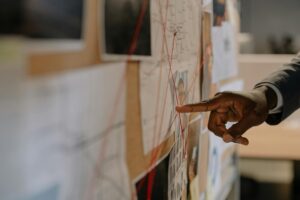From Campus to Career: Career Tips Open Toolkit
Aims: My open toolkit may help contemporary art students gain clearer insight into career prospects. It can effectively help relieve employment pressures and reshape their employment perceptions through psychological support or job opportunities on various websites.

Image source: SHVETS production on Pexels
Step 1: Experience sharing (10 mins)
a) Introduce your previous work experience.
or b) Introduce your career expectations for future employment.

Step 2: Sticky notes summary (5 mins)
a) Create sticky notes to capture keywords after you’ve shared your experiences and expectations.
b) Stick these sticky notes onto a large sheet of paper so you can easily locate the keywords you need.

Image source: cottonbro studio on Pexels
Step 3: Keyword Tracking (10 mins)
This open toolkit provides access to multiple websites and resources concerning arts careers. By tracking keywords, it aims to reshape your understanding of career opportunities within the arts sector and identify effective solutions to address your specific “keyword” challenges.

Image source: Canva Studio on Pexels
Step 4: Peer reflection (5 mins)
a) Discuss with your peers about finding solutions or a new understanding of arts careers.
b) Alternatively, you may add to and discuss the above content (the websites provided by this open toolkit) with your peers.
Further references (in Step 3)
Artstogetherleeds.co.uk. (2025). Networks – Creative Careers – Arts Together. [online] Available at: https://creativecareers.artstogetherleeds.co.uk/networks/ [Accessed 17 Nov. 2025].
Axis. (n.d.). Promoting, supporting, and collaborating with over 10000 artists. [online] Available at: https://axisweb.org/.
Bridgstock, R. (2013). Not a dirty word: Arts entrepreneurship and higher education. Arts and Humanities in Higher Education, 12(2-3), pp.122–137. doi:https://doi.org/10.1177/1474022212465725.
Lingo, E.L. and Tepper, S.J. (2013). Looking Back, Looking Forward: Arts-Based Careers and Creative Work. Work and Occupations, 40(4), pp.337–363. doi:https://doi.org/10.1177/0730888413505229.
Perkbox. (2021). What is EAP Counselling? A Guide to EAP Services | Perkbox. [online] Available at: https://www.perkbox.com/resources/blog/eap-counselling?utm_source=google&gad_source=1&gad_campaignid=939436011&gbraid=0AAAAADwGHc7XakLYa6QYlByeL8UnoF_ML&gclid=Cj0KCQiArOvIBhDLARIsAPwJXOYkM2m2-hZw7ab0kGKvbID69M4Ue_nvvy2y27cQpKSx_944kpcQ3HQaAm8IEALw_wcB [Accessed 17 Nov. 2025].
Petrides, L. and Fernandes, A. (2020). The Successful Visual Artist: The Building Blocks of Artistic Careers Model. The Journal of Arts Management, Law, and Society, 50(6), pp.1–14. doi:https://doi.org/10.1080/10632921.2020.1845892.
Throsby, D. and Zednik, A. (2011). Multiple job-holding and artistic careers: some empirical evidence. Cultural Trends, 20(1), pp.9–24. doi:https://doi.org/10.1080/09548963.2011.540809.
From Campus to Career: Career Tips Open Toolkit © 2025 by Chenchen Feng is licensed under CC BY-NC 4.0


